Reducing HIV Infection in Youths in US: Proposal and Interventions
VerifiedAdded on 2023/06/03
|11
|2463
|199
AI Summary
This research proposal discusses ways to reduce HIV infection in youths in the US. It identifies the target population group, proposes interventions, and discusses expected outcomes, budget, and timeline. The implications for nursing practice and future are also highlighted.
Contribute Materials
Your contribution can guide someone’s learning journey. Share your
documents today.

Running head: HIV IN YOUTHS IN US
HIV in Youths in US
Name of the Student
Name of the University
Author Note
HIV in Youths in US
Name of the Student
Name of the University
Author Note
Secure Best Marks with AI Grader
Need help grading? Try our AI Grader for instant feedback on your assignments.
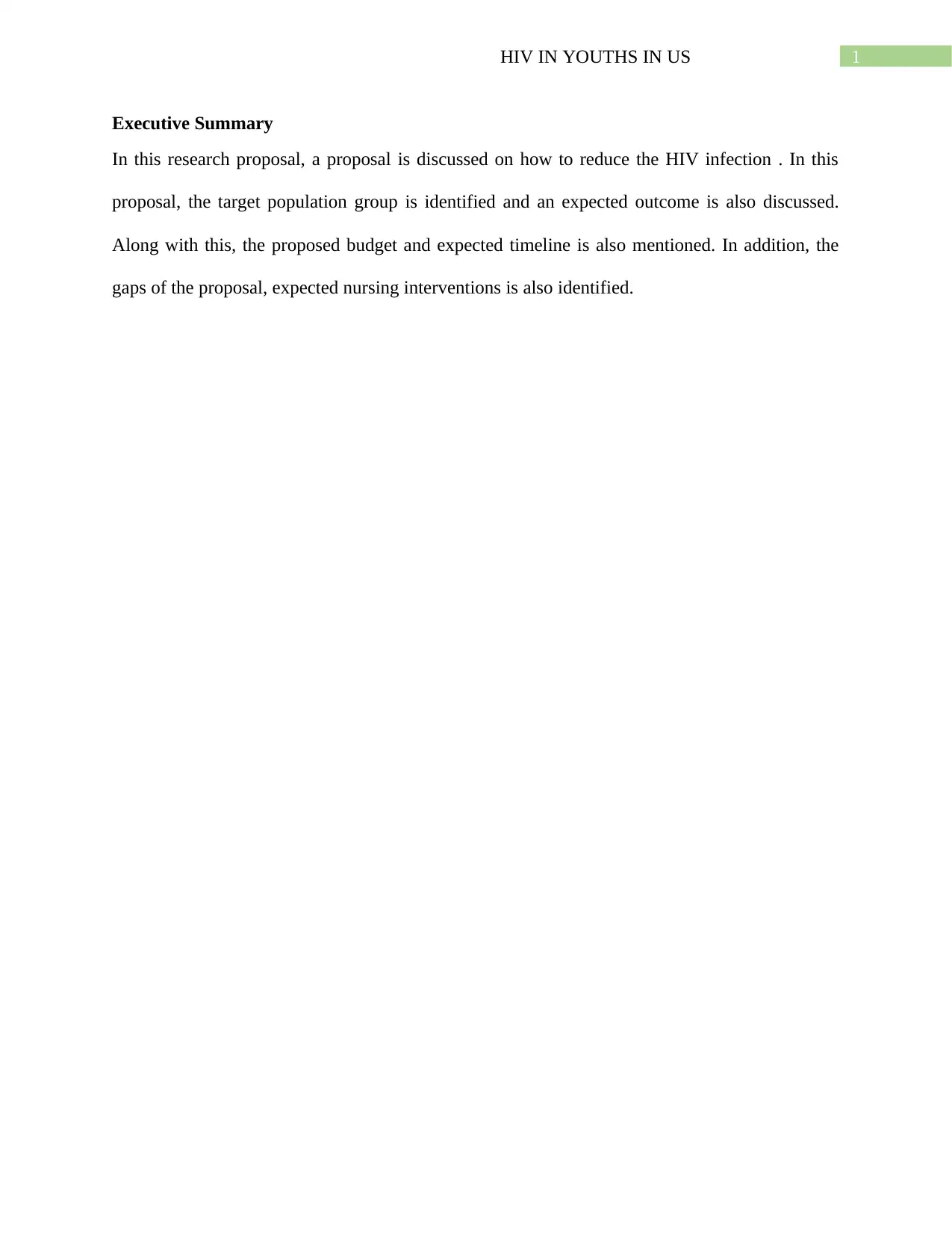
1HIV IN YOUTHS IN US
Executive Summary
In this research proposal, a proposal is discussed on how to reduce the HIV infection . In this
proposal, the target population group is identified and an expected outcome is also discussed.
Along with this, the proposed budget and expected timeline is also mentioned. In addition, the
gaps of the proposal, expected nursing interventions is also identified.
Executive Summary
In this research proposal, a proposal is discussed on how to reduce the HIV infection . In this
proposal, the target population group is identified and an expected outcome is also discussed.
Along with this, the proposed budget and expected timeline is also mentioned. In addition, the
gaps of the proposal, expected nursing interventions is also identified.
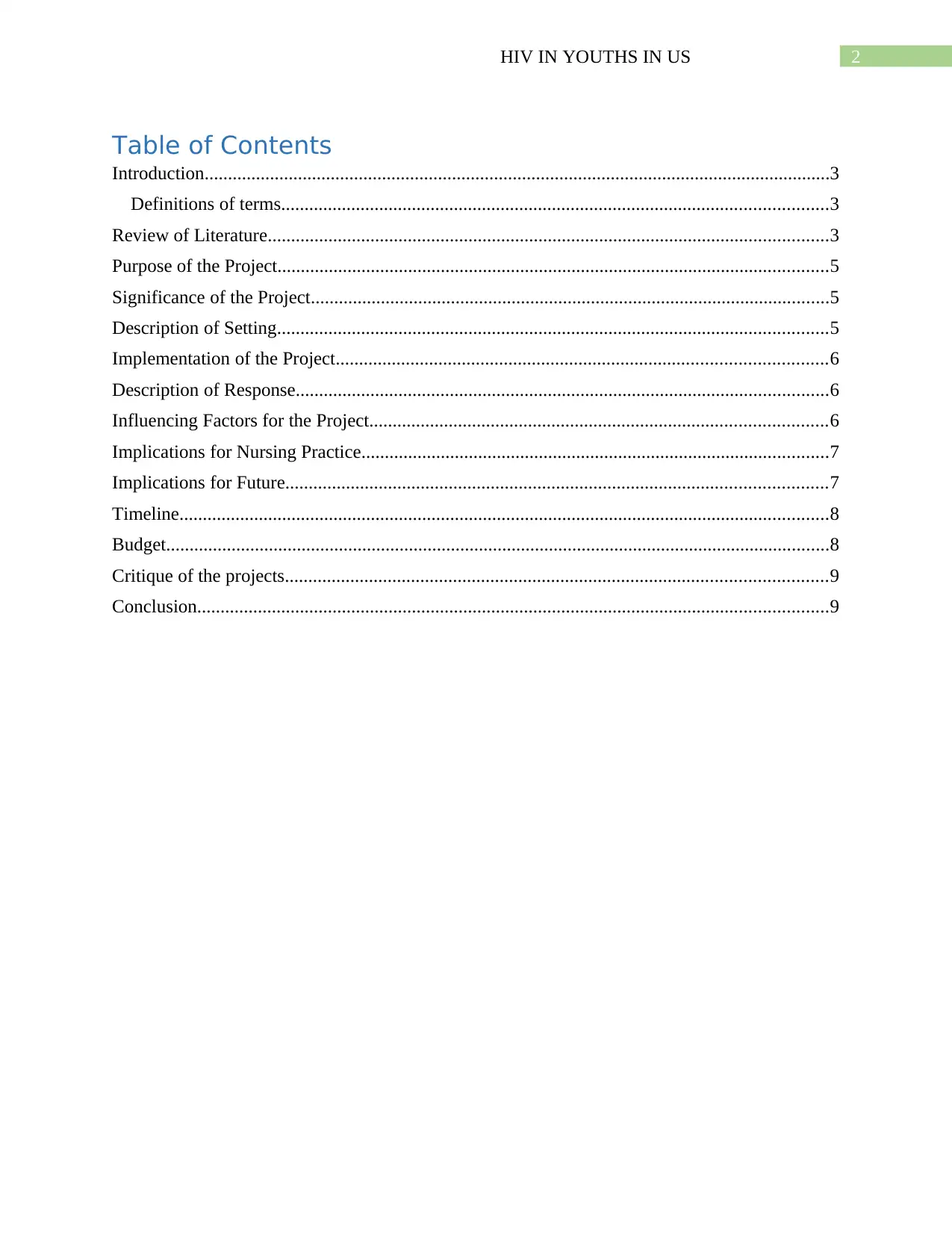
2HIV IN YOUTHS IN US
Table of Contents
Introduction......................................................................................................................................3
Definitions of terms.....................................................................................................................3
Review of Literature........................................................................................................................3
Purpose of the Project......................................................................................................................5
Significance of the Project...............................................................................................................5
Description of Setting......................................................................................................................5
Implementation of the Project.........................................................................................................6
Description of Response..................................................................................................................6
Influencing Factors for the Project..................................................................................................6
Implications for Nursing Practice....................................................................................................7
Implications for Future....................................................................................................................7
Timeline...........................................................................................................................................8
Budget..............................................................................................................................................8
Critique of the projects....................................................................................................................9
Conclusion.......................................................................................................................................9
Table of Contents
Introduction......................................................................................................................................3
Definitions of terms.....................................................................................................................3
Review of Literature........................................................................................................................3
Purpose of the Project......................................................................................................................5
Significance of the Project...............................................................................................................5
Description of Setting......................................................................................................................5
Implementation of the Project.........................................................................................................6
Description of Response..................................................................................................................6
Influencing Factors for the Project..................................................................................................6
Implications for Nursing Practice....................................................................................................7
Implications for Future....................................................................................................................7
Timeline...........................................................................................................................................8
Budget..............................................................................................................................................8
Critique of the projects....................................................................................................................9
Conclusion.......................................................................................................................................9
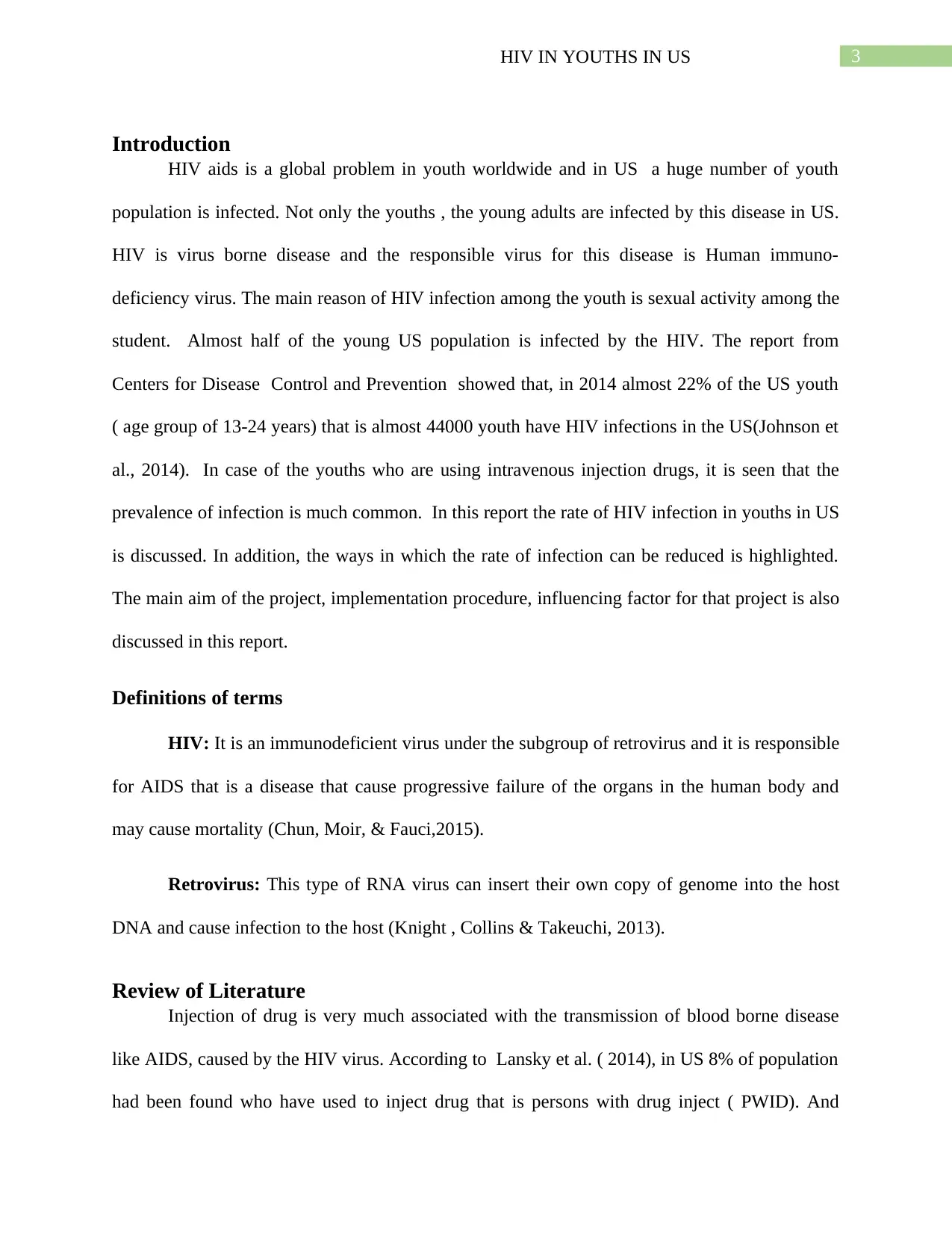
3HIV IN YOUTHS IN US
Introduction
HIV aids is a global problem in youth worldwide and in US a huge number of youth
population is infected. Not only the youths , the young adults are infected by this disease in US.
HIV is virus borne disease and the responsible virus for this disease is Human immuno-
deficiency virus. The main reason of HIV infection among the youth is sexual activity among the
student. Almost half of the young US population is infected by the HIV. The report from
Centers for Disease Control and Prevention showed that, in 2014 almost 22% of the US youth
( age group of 13-24 years) that is almost 44000 youth have HIV infections in the US(Johnson et
al., 2014). In case of the youths who are using intravenous injection drugs, it is seen that the
prevalence of infection is much common. In this report the rate of HIV infection in youths in US
is discussed. In addition, the ways in which the rate of infection can be reduced is highlighted.
The main aim of the project, implementation procedure, influencing factor for that project is also
discussed in this report.
Definitions of terms
HIV: It is an immunodeficient virus under the subgroup of retrovirus and it is responsible
for AIDS that is a disease that cause progressive failure of the organs in the human body and
may cause mortality (Chun, Moir, & Fauci,2015).
Retrovirus: This type of RNA virus can insert their own copy of genome into the host
DNA and cause infection to the host (Knight , Collins & Takeuchi, 2013).
Review of Literature
Injection of drug is very much associated with the transmission of blood borne disease
like AIDS, caused by the HIV virus. According to Lansky et al. ( 2014), in US 8% of population
had been found who have used to inject drug that is persons with drug inject ( PWID). And
Introduction
HIV aids is a global problem in youth worldwide and in US a huge number of youth
population is infected. Not only the youths , the young adults are infected by this disease in US.
HIV is virus borne disease and the responsible virus for this disease is Human immuno-
deficiency virus. The main reason of HIV infection among the youth is sexual activity among the
student. Almost half of the young US population is infected by the HIV. The report from
Centers for Disease Control and Prevention showed that, in 2014 almost 22% of the US youth
( age group of 13-24 years) that is almost 44000 youth have HIV infections in the US(Johnson et
al., 2014). In case of the youths who are using intravenous injection drugs, it is seen that the
prevalence of infection is much common. In this report the rate of HIV infection in youths in US
is discussed. In addition, the ways in which the rate of infection can be reduced is highlighted.
The main aim of the project, implementation procedure, influencing factor for that project is also
discussed in this report.
Definitions of terms
HIV: It is an immunodeficient virus under the subgroup of retrovirus and it is responsible
for AIDS that is a disease that cause progressive failure of the organs in the human body and
may cause mortality (Chun, Moir, & Fauci,2015).
Retrovirus: This type of RNA virus can insert their own copy of genome into the host
DNA and cause infection to the host (Knight , Collins & Takeuchi, 2013).
Review of Literature
Injection of drug is very much associated with the transmission of blood borne disease
like AIDS, caused by the HIV virus. According to Lansky et al. ( 2014), in US 8% of population
had been found who have used to inject drug that is persons with drug inject ( PWID). And
Secure Best Marks with AI Grader
Need help grading? Try our AI Grader for instant feedback on your assignments.
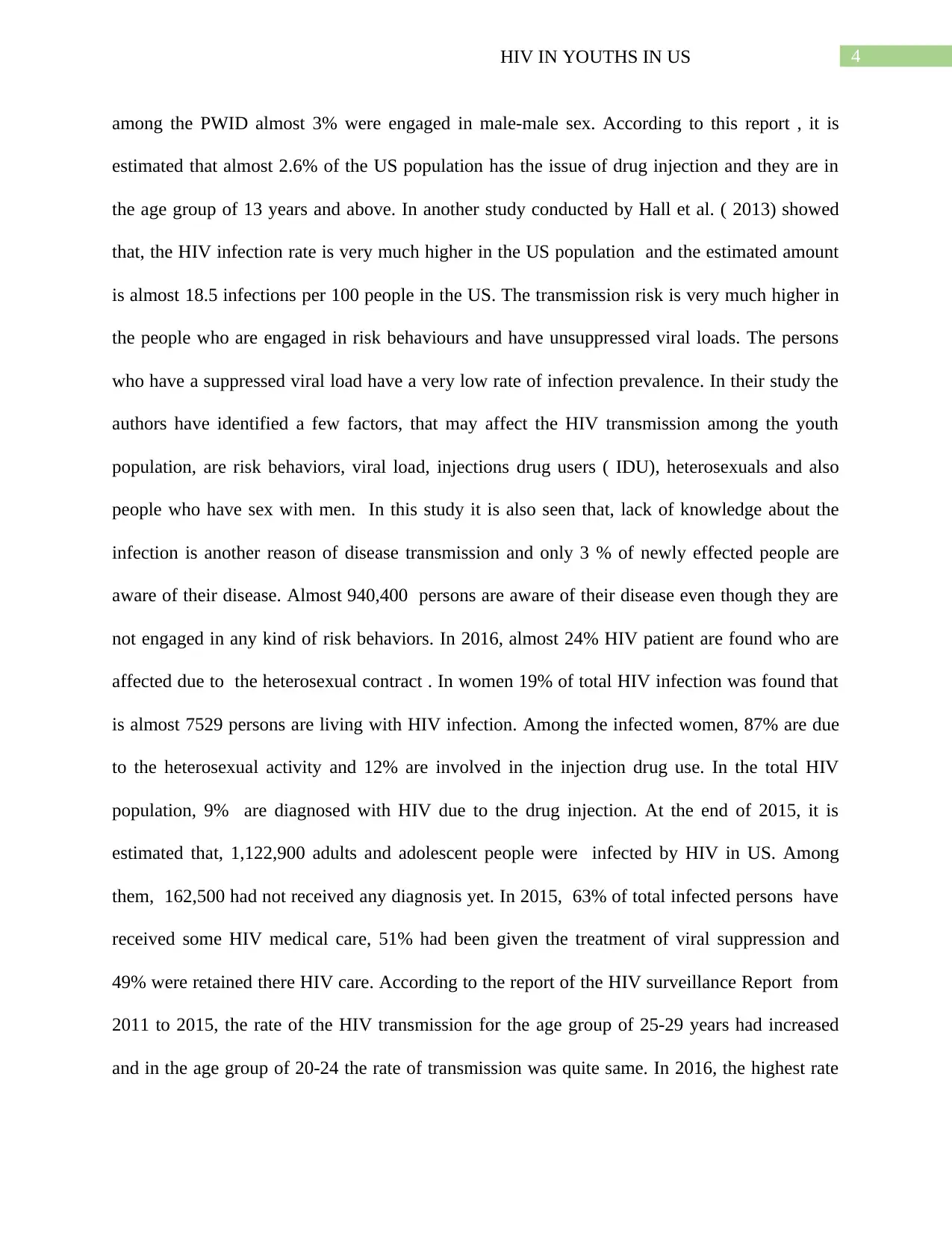
4HIV IN YOUTHS IN US
among the PWID almost 3% were engaged in male-male sex. According to this report , it is
estimated that almost 2.6% of the US population has the issue of drug injection and they are in
the age group of 13 years and above. In another study conducted by Hall et al. ( 2013) showed
that, the HIV infection rate is very much higher in the US population and the estimated amount
is almost 18.5 infections per 100 people in the US. The transmission risk is very much higher in
the people who are engaged in risk behaviours and have unsuppressed viral loads. The persons
who have a suppressed viral load have a very low rate of infection prevalence. In their study the
authors have identified a few factors, that may affect the HIV transmission among the youth
population, are risk behaviors, viral load, injections drug users ( IDU), heterosexuals and also
people who have sex with men. In this study it is also seen that, lack of knowledge about the
infection is another reason of disease transmission and only 3 % of newly effected people are
aware of their disease. Almost 940,400 persons are aware of their disease even though they are
not engaged in any kind of risk behaviors. In 2016, almost 24% HIV patient are found who are
affected due to the heterosexual contract . In women 19% of total HIV infection was found that
is almost 7529 persons are living with HIV infection. Among the infected women, 87% are due
to the heterosexual activity and 12% are involved in the injection drug use. In the total HIV
population, 9% are diagnosed with HIV due to the drug injection. At the end of 2015, it is
estimated that, 1,122,900 adults and adolescent people were infected by HIV in US. Among
them, 162,500 had not received any diagnosis yet. In 2015, 63% of total infected persons have
received some HIV medical care, 51% had been given the treatment of viral suppression and
49% were retained there HIV care. According to the report of the HIV surveillance Report from
2011 to 2015, the rate of the HIV transmission for the age group of 25-29 years had increased
and in the age group of 20-24 the rate of transmission was quite same. In 2016, the highest rate
among the PWID almost 3% were engaged in male-male sex. According to this report , it is
estimated that almost 2.6% of the US population has the issue of drug injection and they are in
the age group of 13 years and above. In another study conducted by Hall et al. ( 2013) showed
that, the HIV infection rate is very much higher in the US population and the estimated amount
is almost 18.5 infections per 100 people in the US. The transmission risk is very much higher in
the people who are engaged in risk behaviours and have unsuppressed viral loads. The persons
who have a suppressed viral load have a very low rate of infection prevalence. In their study the
authors have identified a few factors, that may affect the HIV transmission among the youth
population, are risk behaviors, viral load, injections drug users ( IDU), heterosexuals and also
people who have sex with men. In this study it is also seen that, lack of knowledge about the
infection is another reason of disease transmission and only 3 % of newly effected people are
aware of their disease. Almost 940,400 persons are aware of their disease even though they are
not engaged in any kind of risk behaviors. In 2016, almost 24% HIV patient are found who are
affected due to the heterosexual contract . In women 19% of total HIV infection was found that
is almost 7529 persons are living with HIV infection. Among the infected women, 87% are due
to the heterosexual activity and 12% are involved in the injection drug use. In the total HIV
population, 9% are diagnosed with HIV due to the drug injection. At the end of 2015, it is
estimated that, 1,122,900 adults and adolescent people were infected by HIV in US. Among
them, 162,500 had not received any diagnosis yet. In 2015, 63% of total infected persons have
received some HIV medical care, 51% had been given the treatment of viral suppression and
49% were retained there HIV care. According to the report of the HIV surveillance Report from
2011 to 2015, the rate of the HIV transmission for the age group of 25-29 years had increased
and in the age group of 20-24 the rate of transmission was quite same. In 2016, the highest rate
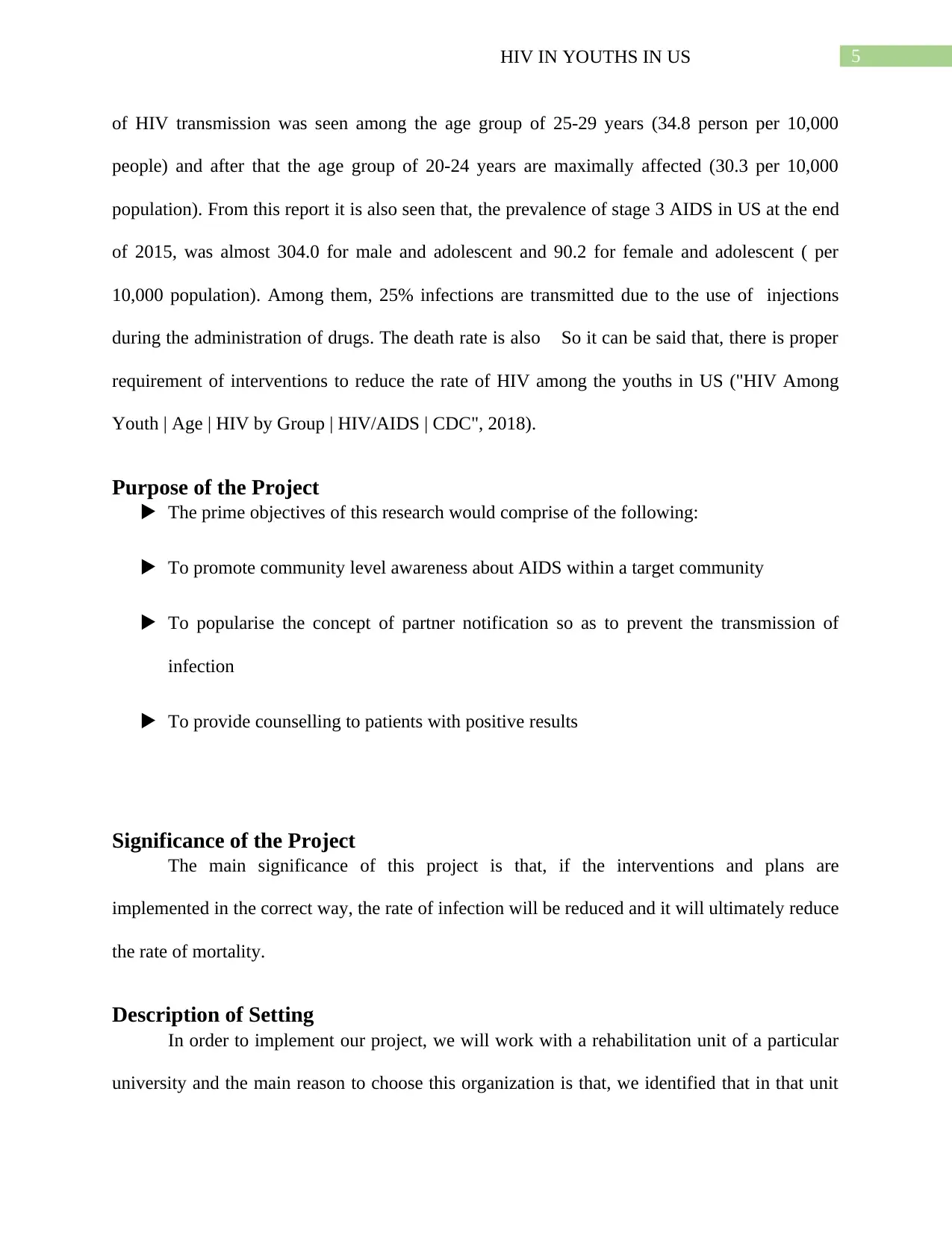
5HIV IN YOUTHS IN US
of HIV transmission was seen among the age group of 25-29 years (34.8 person per 10,000
people) and after that the age group of 20-24 years are maximally affected (30.3 per 10,000
population). From this report it is also seen that, the prevalence of stage 3 AIDS in US at the end
of 2015, was almost 304.0 for male and adolescent and 90.2 for female and adolescent ( per
10,000 population). Among them, 25% infections are transmitted due to the use of injections
during the administration of drugs. The death rate is also So it can be said that, there is proper
requirement of interventions to reduce the rate of HIV among the youths in US ("HIV Among
Youth | Age | HIV by Group | HIV/AIDS | CDC", 2018).
Purpose of the Project
The prime objectives of this research would comprise of the following:
To promote community level awareness about AIDS within a target community
To popularise the concept of partner notification so as to prevent the transmission of
infection
To provide counselling to patients with positive results
Significance of the Project
The main significance of this project is that, if the interventions and plans are
implemented in the correct way, the rate of infection will be reduced and it will ultimately reduce
the rate of mortality.
Description of Setting
In order to implement our project, we will work with a rehabilitation unit of a particular
university and the main reason to choose this organization is that, we identified that in that unit
of HIV transmission was seen among the age group of 25-29 years (34.8 person per 10,000
people) and after that the age group of 20-24 years are maximally affected (30.3 per 10,000
population). From this report it is also seen that, the prevalence of stage 3 AIDS in US at the end
of 2015, was almost 304.0 for male and adolescent and 90.2 for female and adolescent ( per
10,000 population). Among them, 25% infections are transmitted due to the use of injections
during the administration of drugs. The death rate is also So it can be said that, there is proper
requirement of interventions to reduce the rate of HIV among the youths in US ("HIV Among
Youth | Age | HIV by Group | HIV/AIDS | CDC", 2018).
Purpose of the Project
The prime objectives of this research would comprise of the following:
To promote community level awareness about AIDS within a target community
To popularise the concept of partner notification so as to prevent the transmission of
infection
To provide counselling to patients with positive results
Significance of the Project
The main significance of this project is that, if the interventions and plans are
implemented in the correct way, the rate of infection will be reduced and it will ultimately reduce
the rate of mortality.
Description of Setting
In order to implement our project, we will work with a rehabilitation unit of a particular
university and the main reason to choose this organization is that, we identified that in that unit
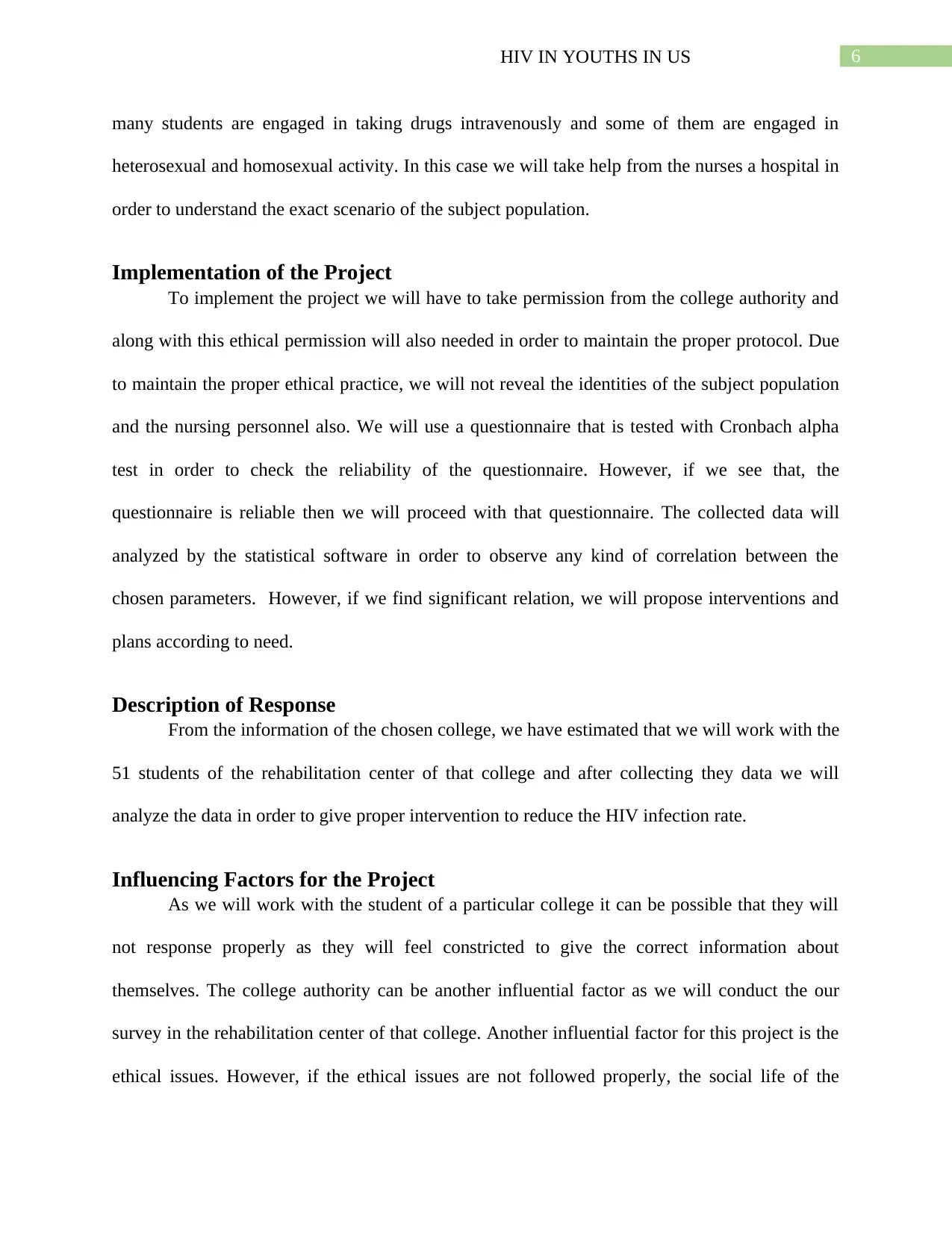
6HIV IN YOUTHS IN US
many students are engaged in taking drugs intravenously and some of them are engaged in
heterosexual and homosexual activity. In this case we will take help from the nurses a hospital in
order to understand the exact scenario of the subject population.
Implementation of the Project
To implement the project we will have to take permission from the college authority and
along with this ethical permission will also needed in order to maintain the proper protocol. Due
to maintain the proper ethical practice, we will not reveal the identities of the subject population
and the nursing personnel also. We will use a questionnaire that is tested with Cronbach alpha
test in order to check the reliability of the questionnaire. However, if we see that, the
questionnaire is reliable then we will proceed with that questionnaire. The collected data will
analyzed by the statistical software in order to observe any kind of correlation between the
chosen parameters. However, if we find significant relation, we will propose interventions and
plans according to need.
Description of Response
From the information of the chosen college, we have estimated that we will work with the
51 students of the rehabilitation center of that college and after collecting they data we will
analyze the data in order to give proper intervention to reduce the HIV infection rate.
Influencing Factors for the Project
As we will work with the student of a particular college it can be possible that they will
not response properly as they will feel constricted to give the correct information about
themselves. The college authority can be another influential factor as we will conduct the our
survey in the rehabilitation center of that college. Another influential factor for this project is the
ethical issues. However, if the ethical issues are not followed properly, the social life of the
many students are engaged in taking drugs intravenously and some of them are engaged in
heterosexual and homosexual activity. In this case we will take help from the nurses a hospital in
order to understand the exact scenario of the subject population.
Implementation of the Project
To implement the project we will have to take permission from the college authority and
along with this ethical permission will also needed in order to maintain the proper protocol. Due
to maintain the proper ethical practice, we will not reveal the identities of the subject population
and the nursing personnel also. We will use a questionnaire that is tested with Cronbach alpha
test in order to check the reliability of the questionnaire. However, if we see that, the
questionnaire is reliable then we will proceed with that questionnaire. The collected data will
analyzed by the statistical software in order to observe any kind of correlation between the
chosen parameters. However, if we find significant relation, we will propose interventions and
plans according to need.
Description of Response
From the information of the chosen college, we have estimated that we will work with the
51 students of the rehabilitation center of that college and after collecting they data we will
analyze the data in order to give proper intervention to reduce the HIV infection rate.
Influencing Factors for the Project
As we will work with the student of a particular college it can be possible that they will
not response properly as they will feel constricted to give the correct information about
themselves. The college authority can be another influential factor as we will conduct the our
survey in the rehabilitation center of that college. Another influential factor for this project is the
ethical issues. However, if the ethical issues are not followed properly, the social life of the
Paraphrase This Document
Need a fresh take? Get an instant paraphrase of this document with our AI Paraphraser
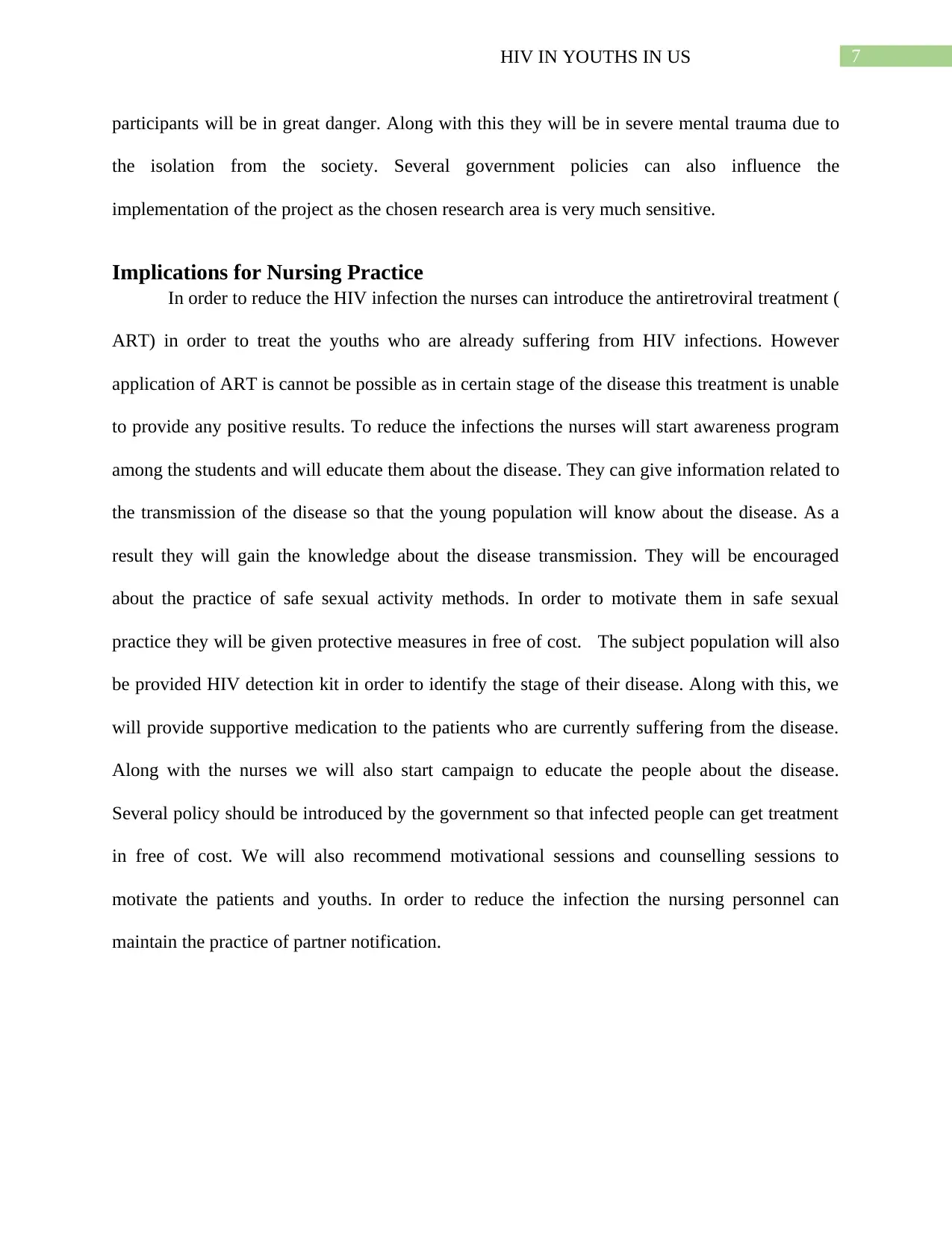
7HIV IN YOUTHS IN US
participants will be in great danger. Along with this they will be in severe mental trauma due to
the isolation from the society. Several government policies can also influence the
implementation of the project as the chosen research area is very much sensitive.
Implications for Nursing Practice
In order to reduce the HIV infection the nurses can introduce the antiretroviral treatment (
ART) in order to treat the youths who are already suffering from HIV infections. However
application of ART is cannot be possible as in certain stage of the disease this treatment is unable
to provide any positive results. To reduce the infections the nurses will start awareness program
among the students and will educate them about the disease. They can give information related to
the transmission of the disease so that the young population will know about the disease. As a
result they will gain the knowledge about the disease transmission. They will be encouraged
about the practice of safe sexual activity methods. In order to motivate them in safe sexual
practice they will be given protective measures in free of cost. The subject population will also
be provided HIV detection kit in order to identify the stage of their disease. Along with this, we
will provide supportive medication to the patients who are currently suffering from the disease.
Along with the nurses we will also start campaign to educate the people about the disease.
Several policy should be introduced by the government so that infected people can get treatment
in free of cost. We will also recommend motivational sessions and counselling sessions to
motivate the patients and youths. In order to reduce the infection the nursing personnel can
maintain the practice of partner notification.
participants will be in great danger. Along with this they will be in severe mental trauma due to
the isolation from the society. Several government policies can also influence the
implementation of the project as the chosen research area is very much sensitive.
Implications for Nursing Practice
In order to reduce the HIV infection the nurses can introduce the antiretroviral treatment (
ART) in order to treat the youths who are already suffering from HIV infections. However
application of ART is cannot be possible as in certain stage of the disease this treatment is unable
to provide any positive results. To reduce the infections the nurses will start awareness program
among the students and will educate them about the disease. They can give information related to
the transmission of the disease so that the young population will know about the disease. As a
result they will gain the knowledge about the disease transmission. They will be encouraged
about the practice of safe sexual activity methods. In order to motivate them in safe sexual
practice they will be given protective measures in free of cost. The subject population will also
be provided HIV detection kit in order to identify the stage of their disease. Along with this, we
will provide supportive medication to the patients who are currently suffering from the disease.
Along with the nurses we will also start campaign to educate the people about the disease.
Several policy should be introduced by the government so that infected people can get treatment
in free of cost. We will also recommend motivational sessions and counselling sessions to
motivate the patients and youths. In order to reduce the infection the nursing personnel can
maintain the practice of partner notification.
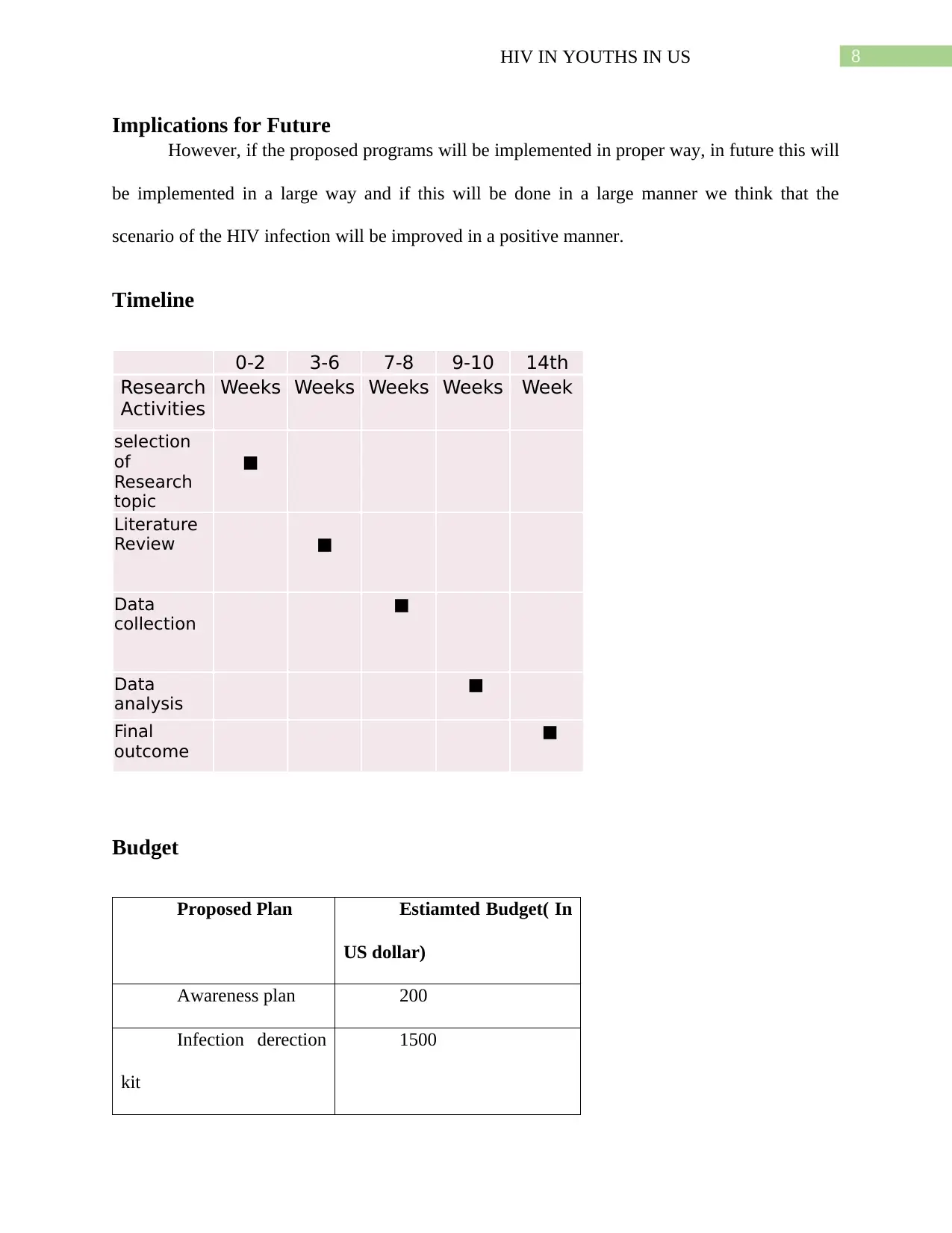
8HIV IN YOUTHS IN US
Implications for Future
However, if the proposed programs will be implemented in proper way, in future this will
be implemented in a large way and if this will be done in a large manner we think that the
scenario of the HIV infection will be improved in a positive manner.
Timeline
0-2 3-6 7-8 9-10 14th
Research
Activities
Weeks Weeks Weeks Weeks Week
selection
of
Research
topic
■
Literature
Review ■
Data
collection
■
Data
analysis
■
Final
outcome
■
Budget
Proposed Plan Estiamted Budget( In
US dollar)
Awareness plan 200
Infection derection
kit
1500
Implications for Future
However, if the proposed programs will be implemented in proper way, in future this will
be implemented in a large way and if this will be done in a large manner we think that the
scenario of the HIV infection will be improved in a positive manner.
Timeline
0-2 3-6 7-8 9-10 14th
Research
Activities
Weeks Weeks Weeks Weeks Week
selection
of
Research
topic
■
Literature
Review ■
Data
collection
■
Data
analysis
■
Final
outcome
■
Budget
Proposed Plan Estiamted Budget( In
US dollar)
Awareness plan 200
Infection derection
kit
1500

9HIV IN YOUTHS IN US
Nursing personnel 2000
Labaratoty cost 1000
Protective
equipment
500
Total 5200
In this project we will estimate that almost 200 dollar will be spent in awareness
programs, $1500 will be spent in buying the infection detection kit, $2000 will be given to the
nursing personnel, laboratory cost will be $1000 and in delivering the protective equipment $500
will be spent.
Critique of the projects
In this project, we will work with the youth population of the US and the drug injection
population of the US. The drawback of this study is that this study will not consider all the
population of US. Along with this, other various factors will not addressed during the study.
Conclusion
Lastly it can be concluded that, with appropriate planning and implementation of the
proposed interventions the expected result will be gained in order to reduce the infection.
Nursing personnel 2000
Labaratoty cost 1000
Protective
equipment
500
Total 5200
In this project we will estimate that almost 200 dollar will be spent in awareness
programs, $1500 will be spent in buying the infection detection kit, $2000 will be given to the
nursing personnel, laboratory cost will be $1000 and in delivering the protective equipment $500
will be spent.
Critique of the projects
In this project, we will work with the youth population of the US and the drug injection
population of the US. The drawback of this study is that this study will not consider all the
population of US. Along with this, other various factors will not addressed during the study.
Conclusion
Lastly it can be concluded that, with appropriate planning and implementation of the
proposed interventions the expected result will be gained in order to reduce the infection.
Secure Best Marks with AI Grader
Need help grading? Try our AI Grader for instant feedback on your assignments.
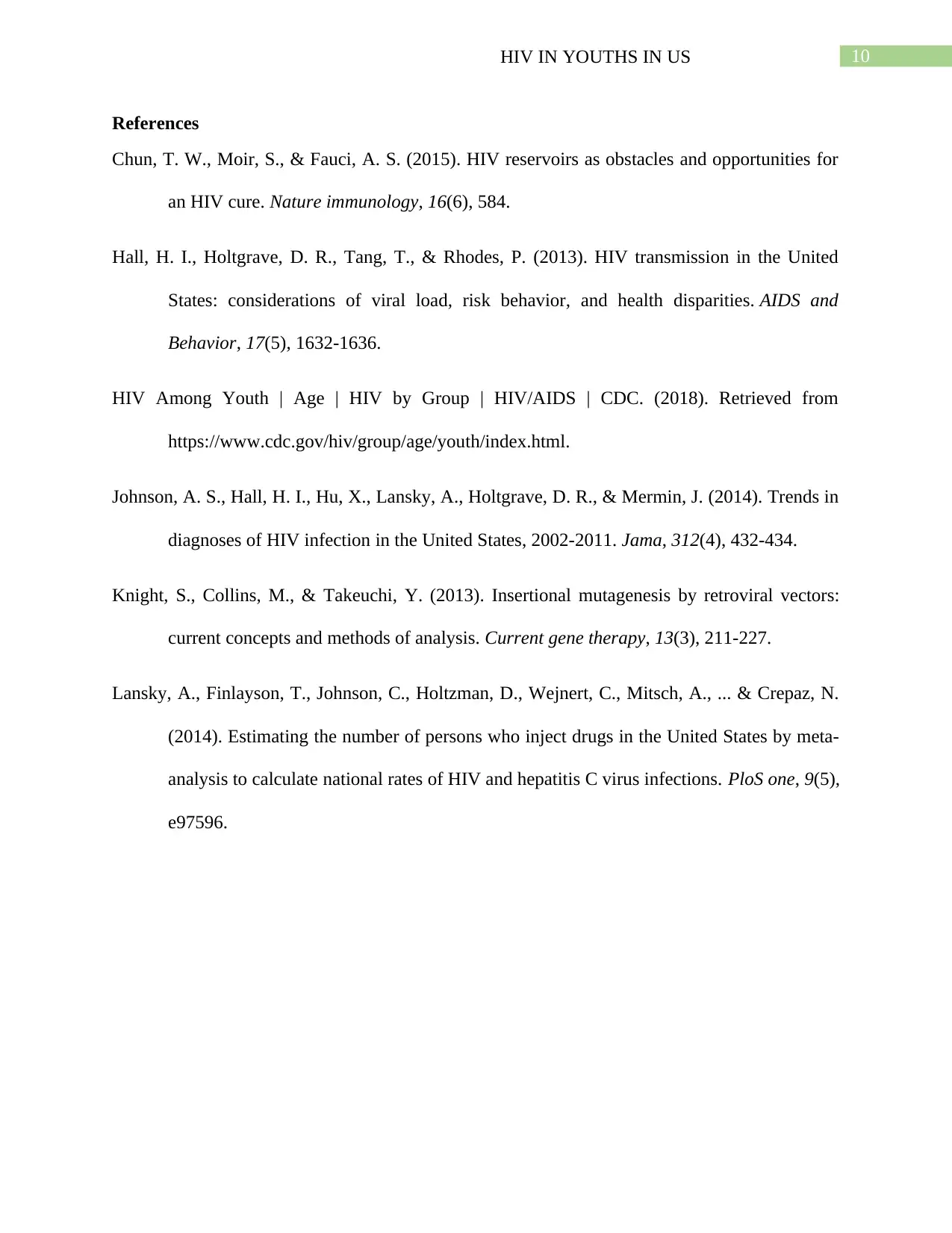
10HIV IN YOUTHS IN US
References
Chun, T. W., Moir, S., & Fauci, A. S. (2015). HIV reservoirs as obstacles and opportunities for
an HIV cure. Nature immunology, 16(6), 584.
Hall, H. I., Holtgrave, D. R., Tang, T., & Rhodes, P. (2013). HIV transmission in the United
States: considerations of viral load, risk behavior, and health disparities. AIDS and
Behavior, 17(5), 1632-1636.
HIV Among Youth | Age | HIV by Group | HIV/AIDS | CDC. (2018). Retrieved from
https://www.cdc.gov/hiv/group/age/youth/index.html.
Johnson, A. S., Hall, H. I., Hu, X., Lansky, A., Holtgrave, D. R., & Mermin, J. (2014). Trends in
diagnoses of HIV infection in the United States, 2002-2011. Jama, 312(4), 432-434.
Knight, S., Collins, M., & Takeuchi, Y. (2013). Insertional mutagenesis by retroviral vectors:
current concepts and methods of analysis. Current gene therapy, 13(3), 211-227.
Lansky, A., Finlayson, T., Johnson, C., Holtzman, D., Wejnert, C., Mitsch, A., ... & Crepaz, N.
(2014). Estimating the number of persons who inject drugs in the United States by meta-
analysis to calculate national rates of HIV and hepatitis C virus infections. PloS one, 9(5),
e97596.
References
Chun, T. W., Moir, S., & Fauci, A. S. (2015). HIV reservoirs as obstacles and opportunities for
an HIV cure. Nature immunology, 16(6), 584.
Hall, H. I., Holtgrave, D. R., Tang, T., & Rhodes, P. (2013). HIV transmission in the United
States: considerations of viral load, risk behavior, and health disparities. AIDS and
Behavior, 17(5), 1632-1636.
HIV Among Youth | Age | HIV by Group | HIV/AIDS | CDC. (2018). Retrieved from
https://www.cdc.gov/hiv/group/age/youth/index.html.
Johnson, A. S., Hall, H. I., Hu, X., Lansky, A., Holtgrave, D. R., & Mermin, J. (2014). Trends in
diagnoses of HIV infection in the United States, 2002-2011. Jama, 312(4), 432-434.
Knight, S., Collins, M., & Takeuchi, Y. (2013). Insertional mutagenesis by retroviral vectors:
current concepts and methods of analysis. Current gene therapy, 13(3), 211-227.
Lansky, A., Finlayson, T., Johnson, C., Holtzman, D., Wejnert, C., Mitsch, A., ... & Crepaz, N.
(2014). Estimating the number of persons who inject drugs in the United States by meta-
analysis to calculate national rates of HIV and hepatitis C virus infections. PloS one, 9(5),
e97596.
1 out of 11
Related Documents
Your All-in-One AI-Powered Toolkit for Academic Success.
+13062052269
info@desklib.com
Available 24*7 on WhatsApp / Email
![[object Object]](/_next/static/media/star-bottom.7253800d.svg)
Unlock your academic potential
© 2024 | Zucol Services PVT LTD | All rights reserved.





